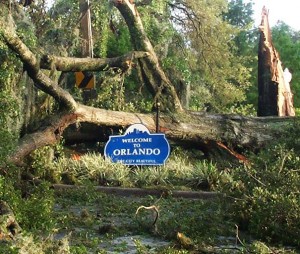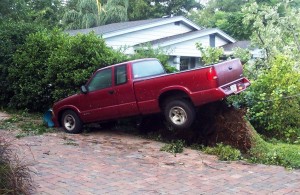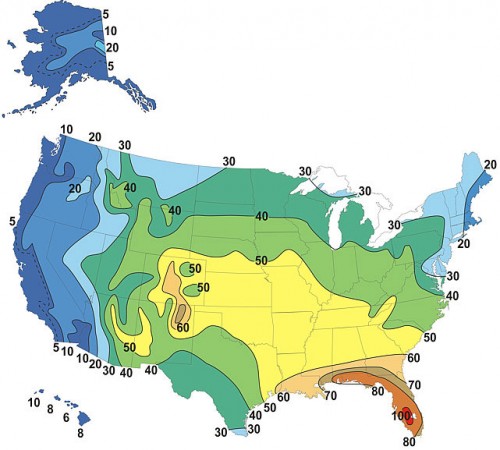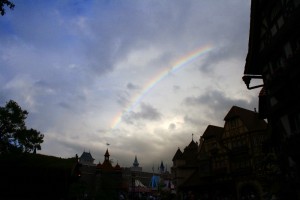Taking Disney World by Storm
First of all, I am not a meteorologist. I don’t even play one on TV.
That being said, I have thirty years of experience in Orlando weather, including doing extensive research on hurricanes.
The 2014 hurricane season has begun, and the year marks the tenth anniversary of Orlando’s “Year of Three Hurricanes”. In this article, I’ll cover the issue of hurricanes and Orlando’s famous thunderstorms as well as how to avoid them and vacation around them.

Officially known as “tropical cyclones” but colloquially as hurricanes, the massive summer storms are one of the most powerful and dangerous natural events on earth. The amount of energy released in one day by an average cyclone in producing rain (which is 400 times greater than the wind energy) is equal to the yearly energy production of the U.S.
So you’re thinking hurricanes and Florida go hand-in-hand like Vermont and snow, right? Well, sort of. Florida is a big state. Not only in terms of square miles, but it’s long. For instance, it takes 12 hours to drive from Key West to Pensacola.
Of course, every mile is a potential hurricane target, but Walt Disney World is only some 40 miles square. Additionally it’s in the center of the state, relatively far from the Atlantic or the Gulf of Mexico. This means every time your local news tells about a hurricane in Florida, it’s unlikely to be passing close to Disney world.
The U.S. government started regular tracking of tropical cyclones in 1851. Looking at those statistics gives excellent news: The frequency of a hurricane passing through the Walt Disney World area in any year is 1 in 10. A 10% chance each year is all local have to worry about. Want even better news? If you’re visiting for a week or two, you have an even smaller chance of having to deal with one of nature’s super storms.
We’ll look at the statistics in a moment, but first let’s have a quick primer. As mentioned before, the scientific name for these storms is tropical cyclone. That’s because when talking about them, one can be referring to hurricanes, tropical storms and tropical depressions. At least it’s all rather simple. It’s all about sustained wind speed:
- Tropical depression: Winds under 38 mph; 62 km/h
- Tropical storm: Winds between 39-73 mph; 63-118 km/h
- Category 1 hurricane: Winds between 74-95 mph; 119-153 km/h
- Category 2 hurricane: Winds between 96-110 mph; 154-177 km/h
- Category 3 hurricane: Winds between 111-129 mph; 178-208 km/h
- Category 4 hurricane: Winds between 130-156 mph; 209-251 km/h
- Category 5 hurricane: Winds over 157 mph; 252 km/h
Tropical cyclones are “born” in the latitudes just north and south of the Equator. Officially, tropical cyclone season is between June 1 and November 30, so there is little chance of a storm during the other six months. Winds, currents and especially warm water temperatures combine to create a storm that has a rapid rotation which is counter-clockwise in the northern hemisphere (this is caused by the Coriolis force, the same effect that determines the direction of rotation of your flushing toilet).
Cyclones that concern Florida form in the Atlantic off the west coast of Africa or in the Caribbean. A cyclone’s directional movement can be anywhere from stationary to around 50 mph; 80 km/h, though 10 mph; 16 km/h is a more normal speed. They can maintain their speed over land, though significant landmasses typically weaken the intensity of storms. For instance, a category 3 hurricane hitting Florida will often lose more than 50% of its energy as it crosses the peninsula.
Cyclones are dangerous for several reasons. Coastal communities have to worry about storm surge: winds pushing waves to immense size which can batter buildings and cause flooding. General flooding is also an issue, since a large storm can drop twenty-five or more inches of rain in only a few hours. There are high winds, which can destroy buildings and knock out power lines. While lightning activity is not prevalent in cyclones, it’s possible and an even more potential concern in larger storms is the creation of destructive tornadoes.
As terrible as that sounds, in reality, central Florida is better situated than most of the state. There’s no need to worry about storm surge. Flooding isn’t a worry either: Orlando is 85 feet above sea level and there are several hundred lakes in the area that can absorb an insane amount of precipitation. Even after the three hurricanes ten years ago there wasn’t hazardous flooding. High winds are an issue, but every powerful storm that has passed through Orlando was slowed down by the land to lessen the potential for damage.
And once again, it’s very unlikely for Walt Disney World visitors to have to deal with a cyclone. Since 1852, central Florida has been directly hit by a category 1 or higher cyclone 17 times. On average, that’s one every 9.5 years. I’ve looked at every storm track, the intensity of each storm and the proximity of the center (“eye”) of the storm in relation to Orlando. So let’s get down to brass tacks:
- A two week trip is 1/12 of the 6 month hurricane season.
- The chance of a dangerous cyclone in each hurricane season is 1/10.
- The chance of a dangerous cyclone hitting Walt Disney World while you’re visiting is about 1/120 (well under 1%).
- The chance of encountering a mild to moderate storm, one that shouldn’t cause many problems, is only 3%.
To be complete, we should talk about safety and preparedness just in case. Here are my suggestions:
- If you plan a trip during summer, the first thing is check for the possibility of cyclones in the area before you leave. Literally, this is something to do less than a week before. If one is approaching, you might want to think about postponing if you can. The National Hurricane Center collects all information about cyclones and will
- give you the latest information. (http://www.nhc.noaa.gov/)
- If a cyclone does appear to be heading your way, look to the front desk of your hotel for advice. They should have a contingency plan. Listen and follow their directions. They can advise you about when to take cover and when it’s safe to visit the parks, etc.
- Depending on the severity and proximity of the storm, each theme park will decide whether to stay open or close. Once again check with your hotel, they should have the latest information.
- If a cyclone is going to hit, get back to your hotel. If you’re camping, speak to the campground staff, they may have to direct you to a nearby hotel or one of the area’s shelters.
- Make sure you have some food and especially water in your hotel room in case you’re stuck there. After a cyclone, don’t trust drinking tap water until you have an all clear from management.
- Watch the TV for news and try to stay away from windows. Hotels are built strong enough to withstand most high winds, but the picture windows in every room are vulnerable.
- The electricity may go out, so remember to charge batteries for phones, etc. before the storm hits.
- This one is very important: In powerful cyclones, the eye is a great doughnut-hole area that is eerily calm. People think this is a good time to go out and take a look around. Unfortunately, some are electrocuted by stepping in standing water that has a downed, but still live, power line touching it. It is also still very possible to be hit by debris. Think about it, how far do you suppose a 2×4 will fly if launched in a 100 mph wind? There’s nothing safe about the cyclone’s eye.
- After the storm has passed, check in with the hotel staff and wait until they give you the all-clear to go outside and look around. Don’t step in water and avoid walking under trees. Trust me; don’t be in a hurry to check out the damage. It will all be there for several days afterwards.

Large tree uprooted lifting truck – the aftermath of Hurricane Charley in 2004. Photo by Thomas Cook
Florida has two seasons. June through September is our “wet” season, while October through May is the “dry”. That’s not to say we don’t get rain in the winter, but it’s summer when Florida develops its remarkable cycle of afternoon thunderstorms.
Lightning Capital of the U.S.
Yes, that’s been said over and over again. People may think it’s something that central Florida chose to call itself, but nobody living here thinks lightning is a wonderful. It’s dangerous and something we live with. A guest asked me the other day, “What’s the big deal about lightning?” I answered, “Several hundred million volts of energy travelling at 100,000 miles an hour.”
Look at the map showing the frequency of thunderstorms created by the National Weather Service. See the red oval with the number 100? Walt Disney World is located just to its north.

Florida thunderstorms develop because of a high level of moisture (humidity) and warm air (over 90F/32C) colliding with cool air (primarily from the Gulf of Mexico). Storms can appear out of nowhere and there’s no need for considerable clouds to produce rain and lightning. There are countless days every summer with drenching rain while the sun shines.
The rain is mostly an annoyance. Like I mentioned before, flooding in the area isn’t a problem. Walt Disney World has been designed to take advantage of Florida’s lakes and sandy soil for remarkable drainage.
On the other hand, lightning is very much something to worry about. It’s unpredictable, which is why all of Florida’s theme parks and attractions take it especially seriously. Part of the proof of their measures is that only a handful of guests and staff have ever been hurt by lightning in the parks. Doing some research, one can find only a couple incidents, both related to water parks. Occurring at Busch Garden’s Adventure Island and SeaWorld’s Discovery Cove, they show that it is almost certainly the connection with water that increases the chance of injury.
In 2011, Discovery Cove, the exclusive “day-spa” where guests can swim with a dolphin, had an incident where three guests and five employees were injured by lightning. Tragically, that same year Adventure Island witnessed the death of a lifeguard working in one of its pools.
This cannot be stressed too strongly: Lightning is dangerous and unpredictable. If you’re outside during a storm, especially if you can see lightning, take cover. Please ignore the guests who keep walking about; if you notice very few cast members outside, even if it’s not raining, that tells you that lightning is nearby.
Each theme park company has state-of-the-art lightning systems. For instance, every building is covered with lightning rods. Generally, guests don’t become aware of these systems until they find that an outside attraction or show is closed. The parks track the proximity of lightning. Lightning strikes within a certain radius cause pools and water play areas to close; outside attractions to shut down; parades and shows to be postponed or cancelled; outside vendors to close up and take cover.

Chances are, if you’re doing a Walt Disney World vacation between June and September you’ll have to deal with Florida’s liquid sunshine and daytime light shows. The easiest thing to do is assume that every day, roughly from 3:00-6:00 PM there will be a storm, so go ahead and plan for it.
- Schedule flights to avoid afternoon arrival or departure. That will lessen delays.
- Pack compact umbrellas and quick dry shirts. Avoid buying ponchos, they’re uncomfortably hot, flimsy, don’t work very well and prove to everyone you failed to plan ahead.
- If you visit a water park, do it in the morning and early afternoon.
- When visiting parks with many outside activities such as the shows at SeaWorld or animal attractions at Animal Kingdom or Busch Gardens, focus on those activities in the morning and save the afternoon for inside pursuits.
- Considering the crowds during the summer, heading to the parks for rope drop is already a good idea. Leave the afternoon for shopping, relaxing and dining either in the parks or at your hotel.
- In the afternoon don’t get in pools and avoid small boats or fishing (three times more people get struck by lightning while fishing than while golfing).
- Listen to cast members about taking cover. They’re not required to tell you of lightning, so if they do, there’s a good reason.
- Understand that if an attraction has been closed down, it’s for your safety as well as the cast members.
- If you’re in a car during a thunderstorm, wait there. It’s safer than running across a giant parking lot.
- Focus on attractions that are not only indoors but have queues that are covered.
- Know that nine times out of ten, the storms dissipate by early evening, leaving a cooler and fresher night ready for all sorts of fun.
I hope this article helps. Too many times I’ve heard people talking about hurricanes as if that’s a reason to avoid Florida in the summer. I’ve also seen too many people completely unprepared for the inevitable thunderstorms. With some basic planning and creativity, anyone can take Walt Disney World by storm!





Hello there, Cool posting. Likely to concern along with your web-site inside i . e ., would probably click here? Web browser nonetheless could be the current market fundamental along with a huge section of others may pass up the excellent composing for this reason trouble.
My family always went to Daytona or Ormond Beach for the Labor Day weekend. In 1985 Hurricane Elena’s heavy rain bands ruined our beach vacation. We went home to Brandon, Florida (east of Tampa) and weren’t that surprised to have to drive through rain the entire way back on I-4, with the notable exception of a few miles of rain-free sunshine around Walt Disney World Resort! Let’s just say we were convinced that Walt must of had a contract with God! 🙂
I am a former CM, and one of my roommates was on the hurricane ride-out team for Hollywood Studios. During the time we lived together, she never had to report, but after I moved back to GA she worked one shut-down there. It’s amazing – and comforting – to know all the measures taken by Disney to ensure the safety of guests, cast, and animals on their property.
In August 2004 I returned as a guest and had the experience of riding out Hurricane Charley at the Poly. The communication from hotel CMs was wonderful. Housekeeping came by once an hour (as long as it was safe) to check on us. We never lost power, thanks to Disney’s underground power lines. And it wasn’t until several days later, when we left and drove out toward the airport, that we realized the destruction that storm brought to Orlando. Cast members get out and clean up as soon as it’s safe to do so; guests wake up and can move along with their vacation plans without knowing all the work that went into getting WDW back into “show-ready” appearance. I’ve ridden out several hurricanes, and by far Charley was the most comfortable, due to Disney’s excellent planning and care.
Thanks for the article. I really enjoyed reading it and learned a lot!
Thanks!
We were staying at Port Orleans French Quarter during Charley. It was quite an experience, but Disney did an excellent job of taking care of us. The parks were closed for only half a day (although the boats & Animal Kingdom were down longer) and they ran Disney movies on three of the television channels non-stop. They also called us every so often to check in and remind us of a few safety things. The one thing we were really grateful for was the trip insurance. I debated about buying it, but it turned out that insurance paid for itself and probably every subsequent trip! Our flight was cancelled for four days, meaning we had to pay rack rate for the hotel to extend our stay. Insurance paid for that and all our meals. The only thing it didn’t cover was park tickets, but we didn’t have a car, so what else were we going to do for four days!? When we got home, we wrote Disney and they ended up sending us vouchers for free tickets for our next trip. Never hurts to ask! And I will say there are way worse places to be stranded than WDW!
Good story!
I was a cast member at Blizzard Beach water park for a few years and the water parks close all rides when lightning is within a 5 mile radius of the park. If you wait around for a while it will pass, but they also offer rain checks to come back another day. However, if it’s just raining, don’t ask for a rain check because you won’t get one. You’re at a water park, does it matter what direction the water is coming from? 🙂
On our October honeymoon in 2005 we were hit with a hurricane, and disney was closed for our first day. After that it was fine with minimal rain, though cold. Now we only travel in April, two weeks after April. 🙂
Oops, I meant two weeks after Easter!
Thanks!
That was Hurricane Wilma. We were there, also. Torrential rain, heavy winds, but no real safety concerns as long as you had the good common sense to stay inside. But it let up during the afternoon, we made it to Downtown Disney for dinner and an evening at DisneyQuest, and a good time was had by all in spite of the hurricane.
Wilma was an intense storm, but it passed on the south side of the area – it wasn’t that big of a deal in Orlando. We were lucky that day.
It’s worth noting that in Hurricane season your Disney Cruise might miss some ports of call and spend extra days at sea and offer more shows and activities on board. Sometimes they might even circle waiting for the port to clear up extending your trip or divert to take on extra food and fuel.
Enjoy the extra sea days…I’ve been on many cruises and missed ports of call and was never really disappointed because the ships themselves are a destination.
And always pack a couple of small flash lights.
Good to note.
Thanks for your personal experiences. If only most of the people who visit central Florida would learn what is safe and what is not.
We visit WDW every August and are quite used to the afternoon thunderstorms. Last summer our flight to MCO landed in one of the storms. The pilot tried to land on two different runways, each time being diverted to another runway due to lightening. It started to feel like we were on a fighter jet (at least what I imagine that might feel like) due to all the tight turns and quick acceleration. Finally, on the third try he was able to land safely. Everyone on the plane clapped and the pilot came over the intercom and said (in a frendly teasing way) “What? You didin’t think we were going to make it?”. We, of course, thanked him as we left the plane. This summer we made sure that we picked a flight that lands earlier so we don’t chance repeating the experience. Our strategy for thunderstorms that strike when we are in the parks is to take cover in a large gift shop or counter service restaurant. We pay attention to the radar on the weather app on our phones and decide where we want to take cover and go there before the storm strikes. It’s no fun getting stuck in a small space with lots of other guests so a little advance planning goes a long way.
We were at WDW once when a hurricane (cat. 1) passed over. They closed at 6PM and re-opened the next day at 3PM. We were in Ft. Wilderness and had to pack up, but other than that there was very little disruption.
The typical afternoon thunderstorm just gives you an opportunity for a break. Just watch out for the lightning, as you said.
By the way, the Coriolis effect does not determine “the direction of rotation of your flushing toilet”. From Wikipedia: “Contrary to popular misconception, water rotation in home bathrooms under normal circumstances is not related to the Coriolis effect or to the rotation of the earth, and no consistent difference in rotation direction between toilets in the Northern and Southern Hemispheres can be observed.”
Len – do you remember what year the Cat. 1 passed over? Was it 2004 or a different year?
While I rarely use Wikipedia as a good source, it looks like further research shows that you’re comment is correct. I learn something new every day.
What a great article!
I worked at WDW during several tropical events, the most significant of which shut down all four theme parks. It’s worth noting that Disney cast worked hard to get Maguc Kingdom open by about 1 PM (it was still raining!) for resort guests. The other parks reopened the next day. Opening MK to resort guests was high priority. So they will get you out of your rooms and back to fun in the parks ASAP!
Thanks for the compliment and the info!
I was a cast member during the 2000 hurricane season and Orlando was a potential target for one of the storms. The day one was supposed to come our way I was working a ticket booth at the TTC and it was the only day my entire time there I did not sell a single ticket. I got off early and made my way to the Magic Kingdom. It was eerie how empty the park was, I was able to walk on to any ride I wanted. The Mad Hatter was so bored he was shuffling his feet. By the end of the day the storm decided to go in a different direction and we only had mild rain.
Thanks for the memory you shared!